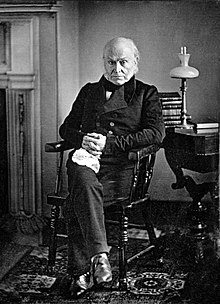John Quincy Adams
As president, Adams called for an ambitious agenda that included federally funded infrastructure projects, the establishment of a national university, and engagement with the countries of Latin America, but Congress refused to pass many of his initiatives.
Though frequently absent because of his participation in the American Revolution, John Adams maintained a correspondence with his son, encouraging him to read works by authors such as Thucydides and Hugo Grotius.
[44] Adams adapted these classical republican ideals of public oratory to the American debate, viewing its multilevel political structure as ripe for "the renaissance of Demosthenic eloquence".
Tsar Alexander attempted to mediate the conflict between Britain and the United States, and President Madison appointed Adams, Secretary of the Treasury Albert Gallatin, and Federalist Senator James A. Bayard to a delegation charged with negotiating an end to the war.
[55] Negotiations finally began in mid-1814 in Ghent, where Adams, Gallatin, and Bayard were joined by two additional American delegates, Jonathan Russell and former Speaker of the House Henry Clay.
[61] In pursuit of national unity, newly elected president James Monroe decided a Northerner would be optimal for the position of Secretary of State, and he chose the respected and experienced Adams for the role.
Adams wanted to delay American recognition of the newly independent republics of Latin America to avoid the risk of war with Spain and its European allies.
However, Andrew Jackson's military campaign in Florida and Henry Clay's threats in Congress forced Spain to cut a deal, which Adams negotiated successfully.
[67] In addition to his foreign policy role, Adams held several domestic duties, including overseeing the 1820 United States census and writing an extensive report on weights and measures.
As the 1824 election approached, Henry Clay, John C. Calhoun (who later dropped out of the race), and William H. Crawford appeared to be Adams's primary competition to succeed Monroe.
[87] While the other candidates based their candidacies on their long tenure as congressmen, ambassadors, or members of the cabinet, Jackson's appeal rested on his military service, especially in the Battle of New Orleans.
Noting the healthy status of the treasury and the possibility for more revenue via land sales, Adams argued for the completion of several projects that were in various stages of construction or planning, including a road from Washington, D.C. to New Orleans.
[86] The domestic agenda of Adams and Clay, which would come to be known as the American System, was designed to unite disparate regional interests in the promotion of a thriving national economy.
[115] Between 1824 and 1828, the United States Army Corps of Engineers conducted surveys for a bevy of potential roads, canals, railroads, and improvements in river navigation.
[123] Aside from Clay, Adams lacked strong supporters outside of the North, and Edward Everett, John Taylor, and Daniel Webster served as his strongest advocates in Congress.
[138] Though many saw Troup as unreasonable in his dealings with the federal government and the Native Americans, the administration's handling of the incident alienated those in the Deep South who favored immediate Indian removal.
[145] Despite the loss of trade with the British West Indies, the other commercial agreements secured by Adams helped expand the overall volume of United States exports.
[148] As part of this goal, the administration favored sending a United States delegation to the Congress of Panama, an 1826 conference of New World republics organized by Simón Bolívar.
[162] No future presidential candidate would match Jackson's proportion of the popular vote until Theodore Roosevelt's 1904 campaign, while Adams's loss made him the second one-term president, after his own father.
[165] He was appalled by many of the Jackson administration's actions, including its embrace of the spoils system[166] and the prosecution of his close friend, Treasury Auditor Tobias Watkins, for embezzlement.
Adams considered the issue of Texas to be "a question of far deeper root and more overshadowing branches than any or all others that agitate the country", and he emerged as one of the leading congressional opponents of annexation.
[187] However, Harrison died in April 1841 and was succeeded by Vice President John Tyler, a Southerner who, unlike Adams, Henry Clay, and many other prominent Whigs, did not embrace the American System.
Polk deployed a military detachment led by General Zachary Taylor to back up his assertion that the Rio Grande constituted the Southern border of both Texas and the United States.
After Taylor's forces clashed with Mexican soldiers north of the Rio Grande, Polk asked for a declaration of war in early 1846, asserting that Mexico had invaded American territory.
[215] Two days later, on February 23, he died at 7:20 p.m. with his wife at his side in the Speaker's Room inside the Capitol Building in Washington, D.C.; his only living child, Charles Francis, did not arrive in time to see his father alive.
[225] In contrast, Adams had a rocky relationship with his mother, due to her high expectations of him, and her fear that her children would follow in the footsteps of her brother, who died of alcoholism.
[171] Biographer and historian William J. Cooper Jr. comments that Adams "does not loom large in the American imagination", but that he has received more public attention since the late 20th century due to his anti-slavery stances.
[233] Historian Daniel Walker Howe writes that Adams's "intellectual ability and courage were above reproach, and his wisdom in perceiving the national interest has stood the test of time".
[237] He has also been praised as a strong prose stylist, with James Parker describing him as one of the "three authentically muddy-eyed and pained-by-subjectivity writers" that the White House has harbored, along with Abraham Lincoln and Barack Obama.
Some sources contend that in 1843 Adams sat for the earliest confirmed photograph of a United States president, although others maintain that William Henry Harrison had posed even earlier for his portrait, in 1841.





















